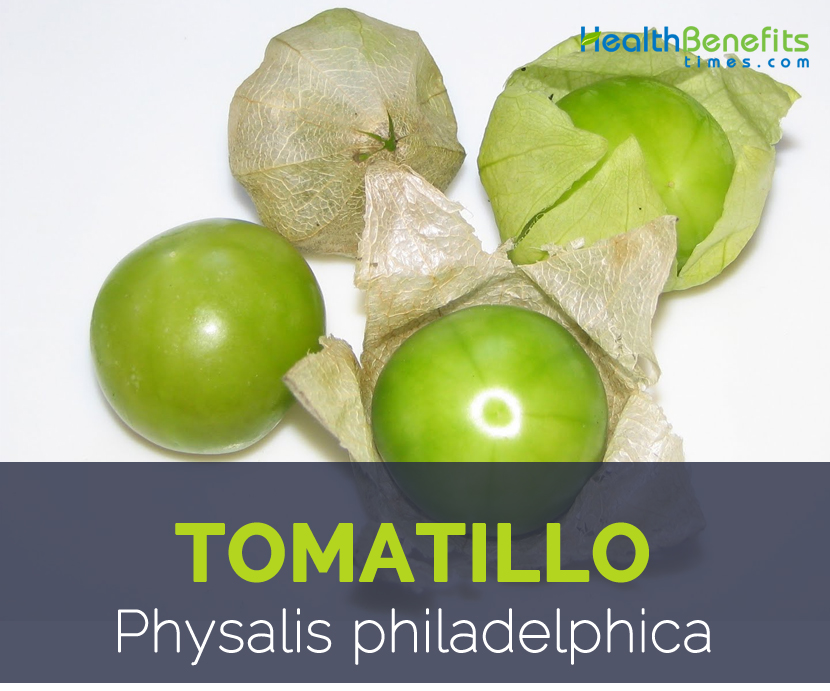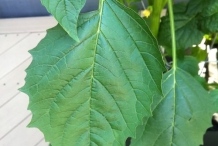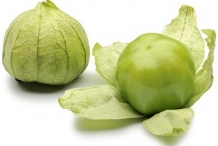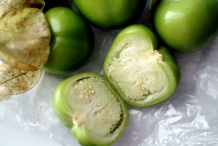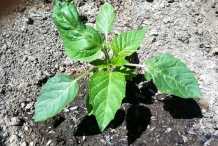Plant
Tomatillo is a small annual glabrous shrub growing up to two to four feet in height. It prefers sunny locations for better production and is found growing in well drained, fertile soil that warms up quickly in the spring. Leaves are normally serrated and can either be smooth or pubescent. Flowers come in several colors including white, light green, bright yellow, and sometimes purple. Flowers may or may not have purple spots toward the center of the corolla.
Fruit
Tomatillos are a small, green Mexican fruit with a Japanese lantern-type shell surrounding it. While they’re from the tomato family, and do look like small, green tomatoes inside the papery covering, tomatillos appear more like cape gooseberries. The fruit resembles a small unripe tomato and is usually green or yellow. The yellow color indicates ripeness, but tomatillos are often used when they are green. The husk that holds the fruit is paper-like and is light brown. The husks are inedible and should be removed before use. When removing the covering, the fruit seems a little sticky but this can be easily washed off. The fruit contains a pectin-like substance that thickens as it cools. The inside is white and meatier than a tomato. The flesh is somewhat acidic with a hint of lemon. Tomatillo should be consumed as soon as it is plucked from the plant, if one decides to store it then they should be kept intact with their husk which prevents them from spoilage. Normally they’re about the size of a large walnut or a small lemon and are 30-50 g.
History
Tomatillos were domesticated in Mexico before the coming of Europeans, and played a significant part in the culture of the Maya and the Aztecs, more important than the tomato. The specific name philadelphica dates from the 18th century. The plant was exported around the world. During 1950s, it was exported to India, where it was grown in Rajasthan; it is grown and processed also in Queensland (Australia), Pietersburg (South Africa), and Kenya. In the United States, tomatillos are grown in California and Iowa. In this way it is now grown throughout the world.
Nutritional value
Apart from their slightly sweeter taste, tomatillo is a good source of nutrients, vitamins and minerals. Consuming 132 gram of tomatillos offers 15.4 mg of Vitamin C, 2.442 mg of Vitamin B3, 0.104 mg of Copper, 13.3 µg of Vitamin K, 0.82 mg of Iron, 0.202 mg of Manganese, 354 mg of Potassium and 51 mg of Phosphorus.
Health benefits of Tomatillos
Tomatillos also called husk cherries or tomato verde are a small, green Mexican fruit that have significant levels of dietary fiber, very few calories, and low levels of fat. Some of the health benefits of tomatillos include its ability to reduce the chances of diabetes, increase the health of your digestive system, lowers gout risks, boost the immune system, slows aging, increase cellular growth, increase energy levels, improves bone density, prevent certain types of cancer, improve vision health, reduces PMS symptoms, lower blood pressure, and can help in weight loss efforts.
1. Blood Pressure and Heart Health
Tomatillos consist of considerable amount of potassium and sodium which is extremely beneficial for maintaining blood sugar level. Potassium acts as a vasodilator which means it helps to relaxes blood vessels, reduces the strain on the cardiovascular system, and encourages circulation and oxygenation to vital parts of the body. Additionally when combined with high fiber content, it can decrease “bad” cholesterol levels, tomatillos promote heart health by decreasing the chances of atherosclerosis, heart attacks, and strokes.(1)
2. Lowers Risk of Gout
Vitamin C present in tomatillo is related with lowering the risk of gout, which is a painful, arthritis type condition mostly afflicting the big toe. The big toe becomes stiff, inflamed and painful as a result of excess uric acid leading to crystals formed in joints. Tomatillo consists of 15.4 mg of vitamin C which is 17.11% of the daily recommended value.
3. Cancer Prevention
Tomatillos also consist of distinctive antioxidant phytochemicals known as withanolides, which have been directly related to anti-cancer and antibacterial functions. Antioxidants help to combat the effects of free radicals that are the hazardous byproducts of cellular reproduction that may kill or mutate healthy cells and turn them into cancerous cells. Furthermore, the vitamin A, vitamin C, and flavonoids within tomatillos provide other cancer-protective effects, mainly in terms of lung and oral cancers.(2)
4. Help Treat Diabetes
Tomatillos consists of vitamin B3 niacin which is helpful for treating diabetes because of the role it plays in balancing blood sugar levels. It’s supposed that vitamin B3 in the form of niacinamide help improve the effectiveness of certain oral drug treatments that are used to control diabetes.
5. Vision Health
Vitamin A has long been associated to the health of our vision. Tomatillos contain beta carotene, a derivative of vitamin A that works as an antioxidant and help to prevents macular degeneration, cataracts, and other conditions that can affect the health of our eyes.(3)
6. Slows Aging
Copper present in tomatillo is considered one of the powerful antioxidant that protects cells against free radical damage. It can help decrease the appearance of wrinkles, age spots, and even macular-degeneration. Tomatillos consist of 0.104 mg of copper which is 11.56% of the daily recommended value.
7. Immune System Health
Tomatillos consist of huge amount of vitamin C which helps to boost the immune system by encouraging the production of white blood cells, the body’s main line of defense against foreign agents and pathogens. Apart from that vitamin C is also a key component of collagen production, which supports the health and creation of skin tissue, as well as the cells and tissues that make up our organs and blood vessels, increasing the body’s sustainability and metabolic functions.
8. Energy Levels
Niacin is a member of the B-family of vitamins that is often ignored in human health. Niacin is actually a key element in the enzymatic processes which help to break down food and complex molecules into usable energy for the body. By increasing the availability of this energy and making the process more efficient, the niacin found in tomatillos can provide you a supportable boost of energy throughout your day.(4)
9. Improves Bone Density
Tomatillos consist of 13.3 µg of vitamin k which is 11.08% of the daily recommended value. Vitamin K helps to increase the amount of a specific protein essential to maintain bone calcium, decreasing the risk of osteoporosis. Research on vitamin K found that high intakes of vitamin K help to stop bone loss in people with osteoporosis. Your body needs vitamin K to use calcium to build bones.
There is increasing evidence that vitamin K improve bone health and decrease the risk of bone fractures, particularly in postmenopausal women who are at risk for osteoporosis.(5)
10. Weight Loss Efforts
Tomatillos are considered one of the favored vegetables for people who are trying to lose weight. High-nutrient, low-calorie, and low-fat vegetables with high fiber content, like tomatillos, help people to feel full, obtain the required nutrients on a daily basis, and decrease the chances of overindulging, because they feel satiated. Tomatillos are perfect if you are trying to reduce obesity for a healthier lifestyle.(6)
11. Speeds up Wound Healing
Iron plays an important role in speeding up the process of wound healing. Since tomatillos consist of considerable amount of iron it helps in the formation of RBCs, the most essential constituent of hemoglobin that transports oxygen around the body. Without the proper supply of oxygen, wound healing cannot take place.(7)
12. Digestive Health
Most of the vegetables have a high level of dietary fiber, and tomatillos are no exclusion. This means that they are very good for digestive health, as fiber help to add bulk to foods and speed their transit through the digestive tract, thus eliminating constipation, excess gas, bloating, cramping, and even more severe conditions like colon cancer and gastric ulcers. Additionally, fiber is very good at regulating the release of carbohydrates (simple sugars) into the bloodstream, thus regulating blood sugar levels, which is significant for people suffering from diabetes, who need to strictly control their glucose and insulin levels.(8)
13. Reduces PMS Symptoms
Consuming sufficient amount of manganese together with calcium help to improve symptoms of PMS like tenderness, muscle pain, anxiety, mood swings and trouble sleeping and work as a natural remedy for PMS. Research published in the American Journal of Obstetrics and Gynecology found that women who have lower levels of manganese in their blood experienced more pain and mood-related symptoms during pre-menstruation.(9)
How to Eat
- Tomatillos are the main ingredients of variety of Mexican mole (sauce) preparations.
- Berries are normally used in Enchilada verde (green) sauce.
- To prepare salsa verde, cooked and pureed green tomato, blended with roasted jalapeno, onions, garlic, herbs like cilantro and served over tortilla, seafood, fritters, etc.
- Guacamole is a popular avocado based Mexican spread prepared with chopped tomate, peppers, onion, lime juice, and served over tortilla chips.
- It’s normally used in salsas as well as stews and sauces for meats.
- It is also made into jams and marmalades.
Other traditional uses and benefits of Tomatillos
- In Mexico a concoction made of the flower calyces is used to treat Diabetes.
- The fruits are also used as a remedy for fever.
Precautions
- As a member of nightshade family plants, tomatillos often cause allergic-reactions in some sensitized persons with symptoms of skin and eye itching, runny nose, gastrointestinal disturbances like pain abdomen, vomiting and diarrhea.
References:
http://www.foodreference.com/html/art-tomatillo.html
http://www.zhion.com/herb/Tomatillo.html
http://americanhistory.si.edu/blog/2012/09/the-tomatillo-tohm-ah-tee-oh.html
http://www.hungrymonster.com/food-facts/food_facts.php?p=Fruits&fid=5950
https://bonnieplants.com/growing/growing-tomatillos/
https://www.uky.edu/Ag/CCD/introsheets/tomatillo.pdf
http://whatscookingamerica.net/tomatillos.htm
https://en.wikipedia.org/wiki/Tomatillo
https://www.hort.purdue.edu/newcrop/1492/tomatillo.html
Comments
| Tomatillo Quick Facts | |
|---|---|
| Name: | Tomatillo |
| Scientific Name: | Physalis philadelphica |
| Origin | Mexico |
| Colors | Yellow, green, or even purple. |
| Shapes | Small spherical shaped berry about 2.5-4 cm in diameter, |
| Taste | Slightly sweeter taste |
| Calories | 42 Kcal./cup |
| Major nutrients | Vitamin C (17.11%) Vitamin B3 (15.26%) Copper (11.56%) Vitamin K (11.08%) Iron (10.25%) |
| Health benefits | Reduces PMS Symptoms, Digestive Health, Speeds up Wound Healing, Weight Loss Efforts, Improves Bone Density, Energy Levels,Immune System Health, Slows Aging, Vision Health, Help Treat Diabetes, Cancer Prevention, Lowers Risk of Gout, Blood Pressure and Heart Health |
| More facts about Tomatillo | |
| Rank | Scientific Name & (Common Name) |
|---|---|
| Kingdom | Plantae (Plants) |
| Subkingdom | Tracheobionta (Vascular plants) |
| Superdivision | Spermatophyta (Seed plants) |
| Division | Magnoliophyta (Flowering plants) |
| Class | Magnoliopsida (Dicotyledons) |
| Subclass | Asteridae |
| Order | Solanales |
| Family | Solanaceae (Potato family) |
| Genus | Physalis L. (Groundcherry) |
| Species | Physalis philadelphica Lam. (Mexican groundcherry) |
| Synonyms |
|


